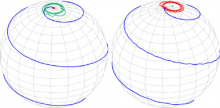
Abstract
We perform a full numerical simulation of binary spinning black holes to display the long term spin dynamics. We start the simulation at an initial proper separation between holes of d~25M and evolve them down to merger for nearly 48 orbits, 3 precession cycles and half of a flip-flop cycle. The simulation lasts for t=20000M and displays a change in the orientation of the spin of the secondary black hole from initially aligned with the orbital angular momentum to a complete anti-alignment after half of a flip-flop cycle. This process continuously flip-flops the spin during the lifetime of the binary. We discuss the consequences of this oscillation mode for accreting binaries, in particular for the spin growth and binary dynamics as well as the observational consequences for galactic and supermassive black holes.